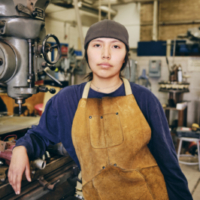Black women, Black femmes, and Black queers in New Orleans hustle as a culture of resistance.
The National Employment Law Project (NELP) has teamed up with Project Hustle to document the working lives of Black women and femmes in New Orleans, focusing on the impacts of criminalization, care work, and occupational segregation.
Project Hustle is a Black, queer, hood feminist-led transformative organizing project in Southeast Louisiana. The project celebrates how Black women and femmes have created alternatives to job exploitation by building the infrastructure to support one another, free loved ones from incarceration, and resist in a state perennially ranked the “incarceration capital” of the world.
NELP and Project Hustle will continue to share stories and resources to support Black women’s power building campaigns in New Orleans. See Project Hustle’s online home for additional resources and stories: www.southernprojecthustle.org.
Across the United States, working-class Black women shoulder the financial costs of criminalization.[1] In New Orleans, not only are Black women 55% more likely than white women to be arrested,[2] Black women’s work in caring for and supporting loved ones as they are prosecuted and incarcerated too often goes unrecognized and unseen.
For members of Project Hustle in New Orleans, building hustles[3] is about creating an alternative future where the forces of criminalization, debt peonage, and exploitative jobs are eclipsed by Black women’s cooperatives, bodily agency, and worker power.
Building hustles is about creating an alternative future where the forces of criminalization, debt peonage, and exploitative jobs are eclipsed by Black women’s cooperatives, bodily agency, and worker power.
Here, hustles—far from merely a story of survival or boot-strapping entrepreneurship—are stories of deliberate and collective resistance against both criminalization and being pushed into racialized and gendered occupations defined by dead-end jobs, unsafe working conditions, and poverty wages. In a state regularly ranked the “incarceration capital of the world,”[4] hustles are practices tied to the long history of Southern Black women, Black femmes, and Black queer workers providing mutual aid and pushing for freedom in a historical context of anti-Black slavery and a current context of anti-Black criminalization.
The need to support loved ones targeted by criminalization can play an outsized role in pressuring Black women workers in New Orleans to stay in underpaid, bad jobs.[5] As Project Hustle member Geneva Joy Hughes explains, “I did deal with the temp agency stuff longer because I knew I needed that check next week, because he needed money on his books, or we might need to go pick him up, what’s he going to do when he comes home … that was intense … it was always the fees.” Burdensome financial costs associated with criminalization are widely documented, including paying court fines and fees, filling phone call accounts, filling commissary accounts, affording transportation to court and rural prisons, paying lawyers’ fees, paying for court-mandated classes, paying bail and bonds, and paying conviction fees.[6]
Such costs—combined with long-standing structural racism, sexism, and broad declines in worker power[7]—have contributed to pushing Black women workers in New Orleans into the lowest-paid jobs and industries, and, notably, employment within the carceral system (see Tables 1 and 2 below). Of the most common industries where New Orleans Black women work, carceral employment (wage work in jails, prisons, courts, probation offices, parole offices and contracted private agencies that conduct surveillance or other “safety” services related to the carceral state) ranks as the second highest-paying, behind only hospitals (see Table 3 below).
As a result, Black women in New Orleans are simultaneously overrepresented in incarceration rates and more likely than other groups to be employed by the punishment system, in jobs that are often the highest-paying jobs available but also the most unsafe. As Project Hustle member and former corrections officer Tamara Nelson shares, “The jail was the highest paying job around … I caught COVID three times working in that jail house. It wasn’t good on my mental state or health.” Further, oral histories collected by Project Hustle and NELP suggest that Black women workers are predominantly employed in entry level corrections officer positions, with limited likelihood of promotion.
The oral histories and data collected by Project Hustle and NELP are necessary for understanding how Black women, Black femmes, and Black queer workers in New Orleans are already pushing to dismantle the twin forces of exploitative jobs and criminalization. While the research behind the tables above is incomplete,[8] the tables above taken together with Project Hustle’s oral histories suggest a carceral system that not only criminalizes, targets, and financially burdens Black New Orleanians, but additionally relies on the dead-end, entry-level employment of Black New Orleanians, particularly Black women.
More soon. Visit Project Hustle at www.southernprojecthustle.org.
Endnotes
[1] In a multi-state survey that included Louisiana, researchers concluded that the average debt incurred from court-related fines and fees and conviction-related costs is around $13,607. In 63% of cases surveyed, family members on the outside were primarily responsible for court-related costs associated with conviction. Of family members responsible for these costs, 83% were women. Saneta deVouno-powell, Chris Schweidler, Alicia Walters, and Azadeh Zohrabi, Who Pays? The True Cost of Incarceration on Families, Ella Baker Center, Forward Together, Research Action Design, 2015. https://www.whopaysreport.org/wp-content/uploads/2015/09/Who-Pays-FINAL.pdf
[2] Additionally, Black men are 50% more likely than white men to be arrested in New Orleans. Rose Wilson, Theresa McKinney, Mathilde Laisne, Corinna Yazbek, New Orleans: Who’s in Jail and Why? Vera New Orleans, 2017, https://www.vera.org/publications/new-orleans-jail-population-quarterly-report
[3] “Hustling” commonly refers to income-generating forms of work outside of traditional employment relationships. At the same time, “hustling” can amount to an anti-worker imperative to “hustle harder,” a call that individuates human needs unmet and exacerbated by the formal economy. Members of Project Hustle reject this anti-social, individualizing formulation.
[4] Emily Widra, Tiana Herring, States of Incarceration: The Global Context 2021, Prison Policy Initiative,
https://www.prisonpolicy.org/global/2021.html
[5] Gina Clayton, Endria Richardson, Lily Mandlin, and Brittany Farr, Because She’s Powerful: The Political Isolation and Resistance of Women with Incarcerated Loved Ones, Essie Justice Group, 2018, https://www.becauseshespowerful.org/wp-content/uploads/2018/05/Essie-Justice-Group_Because-Shes-Powerful-Report.pdf. See also, Addressing Occupational Segregation Means Centering Black Women Workers, Kemi Role, NELP, https://www.nelp.org/blog/addressing-occupational-segregation-means-centering-black-women-worker
[6] Vera New Orleans estimates that Black New Orleanians pay $8.7 million in cash bail and conviction fees in 2017. Jon Wool, Alison Shih, Melody Chang, Pay in Full: A Plan to End Money Injustice in New Orleans, Vera New Orleans, 2019, https://www.vera.org/downloads/publications/paid-in-full-report.pdf
[7] Worker power refers to the ability of workers to influence their working conditions and have a say in decisions that affect their jobs. For instance, worker power is closely related to the extent to which workers can negotiate for a greater share of the profits they create—as compared to employers, shareholders, executives, and creditors. See, e.g., Low Wage Workers are Suffering from a Decline in the Real Value of the Federal Minimum Wage, 2019, Economic Policy Institute, https://www.epi.org/publication/labor-day-2019-minimum-wage and CEO Pay has Skyrocketed 1,460% Since 1978, Economic Policy Institute, 2022, https://www.epi.org/publication/ceo-pay-in-2021. I address some of the intersections between worker power and criminal punishment in Worker Power in the Carceral State, 2022, https://www.nelp.org/publication/worker-power-in-the-carceral-state-10-policy-proposals-against-the-criminalization-of-workers. See also, A Clean Slate for Worker Power, Harvard Law School’s Labor and Worklife Program, 2019, https://www.cleanslateworkerpower.org.
[8] Wages, for instance, specifically of Black women workers in Table 3 were not available at the time this blog was posted.

| Black women | $16.01 |
| Latinx women | $16.75 |
| Black men | $18.49 |
| Latinx men | $19.29 |
| White women | $23.88 |
| White men | $28.75 |
| All other women | $17.69 |
| All other men | $21.92 |
Source: NELP & Movement Economics analysis of IPUMS American Community Survey 2017-2021. Note: Hourly wages were inflated to 2021 dollars using the CPI-W for the South.

| Black women | 27.70% | 22.50% |
|---|---|---|
| Black men | 22.50% | 16.50% |
| White women | 15.40% | 21.90% |
| White men | 26.60% | 24.70% |
| Latina women | 1.30% | 3.50% |
| Latino men | 3.70% | 4.60% |
| All other women | 2.00% | 4.70% |
| All other men | 3.50% | 5.60% |
Carceral system employees and all employees by race and gender, New Orleans 2017-2021. Source: NELP & Movement Economics analysis of IPUMS American Community Survey 2017-2021. Note: Cells report column percentages. Carceral employees are defined as those that work in 9470 Justice, public order, and safety activities industry. This includes employees in this industry in both public and private sectors.

| General medical and surgical hospitals, and specialty (except psychiatric and substance abuse) hospitals | 27.48 |
|---|---|
| Justice, public order, and safety activities | 25.19 |
| Colleges, universities, and professional schools, including junior colleges | 23.94 |
| Elementary and secondary schools | 23.02 |
| Individual and family services | 19.13 |
| Nursing care facilities (skilled nursing facilities) | 17.31 |
| Other amusement, gambling, and recreation industries | 16.11 |
| Traveler accommodation | 15.15 |
| Restaurants and other food services | 13.02 |
| Home health care services | 12.25 |
Source: NELP & Movement Economics analysis of IPUMS American Community Survey 2017-2021. Note: Hourly wages were inflated to 2021 dollars using the CPI-W for the South.
Related to
The Latest News
All newsNew Survey of Jobless Workers Reveals How Critical Unemployment Insurance System Falls Short

News Release
Workers Rights Organizations Condemn the Dismantling of Workplace Civil Rights Enforcement Agency

News Release
March Jobs Report: Immigrant Workers Power a Steady Economy, Full Impact of Trump Policies Yet to Come

News Release

